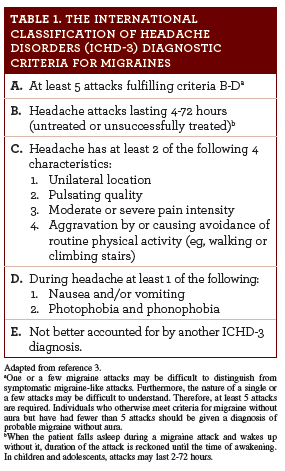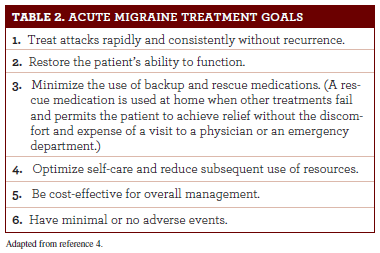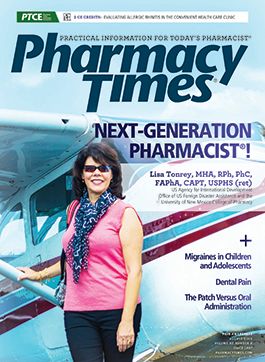Migraines in Children and Adolescents
The incidence and impact of migraines in children and adolescents is concerning.
The incidence and impact of migraines in children and adolescents is concerning. Between 8% and 23% of children between 11 and 18 years of age experience migraines.1 Migraines can impede daily functioning in affected children and adolescents. The results of a comparative study showed that affected children were absent from school, did not perform household tasks, and did not participate in leisure activities for about 24 days during the 3 months following their last migraine attack.2 These data highlight the need to implement appropriate treatment and implement preventive measures for migraines in children and adolescents.
The American Academy of Neurology (AAN), the Child Neurology Society (CNS), and the American Headache Society (AHS) published migraine treatment guidelines for children and adolescents in December 2004. However, data on alternative abortive migraine treatment in children and adolescents have been limited.1 Although the adult migraine treatment and prophylaxis guidelines were updated in 2012, the guidelines for migraine treatment and prophylaxis in children and adolescents have not been updated. Because of these limitations, pharmacists may not be aware of the ideal migraine treatment and prophylaxis in pediatric patients. This article highlights migraine treatment recommendations from the 2004 guidelines, reviews clinical studies validating clinical utility of newer migraine treatment options following publication of the 2004 guidelines, and discusses pertinent patient counseling points.

MIGRAINE TREATMENT
The third beta edition of the International Classification of Headache Disorders (ICHD-3) contains diagnostic criteria for migraines (Table 1).3 Goals for acute migraine treatment were established in the AAN guidelines in 2000 (Table 2).4 The 2004 guidelines by the AAN, CNS, and AHS covered 3 medications for use in acute migraine attacks in children and adolescents: ibuprofen (level A); acetaminophen (level B); and sumatriptan nasal spray (level A).1 Since 2004, additional studies have validated the safety and efficacy of alternative triptans in children and adolescents (Table 3).26,27 Adolescents should not use aspirin or aspirin- containing products (eg, Excedrin, Fiorinal) due to the risk of developing Reye’s syndrome.
Ibuprofen
Ibuprofen is a nonsteroidal anti-inflammatory drug (NSAID) that has been extensively studied. Two double-blind, placebo-controlled trials identified the safe and effective use of ibuprofen 7.5 to 10 mg/kg for migraines in patients 4 to 16 years of age.5,6 Fifty-six percent of patients who took ibuprofen experienced headache relief in 2 hours after dosing compared with 53% of patients who took acetaminophen. For acute migraine attacks, the recommended dose is 7.5 to 10 mg/kg per dose (maximum dose: 800 mg) every 6 to 8 hours (maximum daily dose: 2400 mg).1

Acetaminophen
In patients between 4 and 16 years of age, acetaminophen 15 mg/ kg effectively reduced pain by at least 2 points on a 5-point scale, compared with placebo, at 1 and 2 hours after migraine attacks; adverse effect rates were similar for placebo and acetaminophen groups.5 The recommended dose for acetaminophen is 10 to 15 mg/ kg per dose (maximum daily dose: 1000 mg) every 4 to 6 hours (no more than 5 doses per 24 hours, or 3 g daily).
Nasal Sumatriptan
The 2004 guidelines noted that the use of 5, 10, and 20 mg of nasal sumatriptan in children and adolescents resulted in significant headache relief at 1 and 2 hours compared with placebo.1 Additionally, nasal sumatriptan was well tolerated in adolescent patients, with the most common adverse effect being taste disturbance.7,8 Even though there were inadequate data from the 2004 guidelines to support or refute oral triptan use, studies published after 2004 note the clinical safety and efficacy of alternative oral triptans in children and adolescents.

Additional Data on Triptans
Alternative dosage forms of sumatriptan (ie, oral tablet and subcutaneous injection) are not recommended for pediatric use because safety and efficacy data for children and adolescents have not been established.9,10 Use of the combination of sumatriptan and naproxen, however, demonstrated significantly high 2-hour pain-free rates compared with placebo in a randomized, parallel study of adolescents aged 12 to 17 years in acute migraine treatment.11 Moreover, compared with pediatric patients taking placebo, the following rates in pediatric patients taking the 85/500-mg sumatriptan/naproxen combination product were significantly superior: sustained pain relief at 24 hours; 2-hour photophobia-free rates; and 2-hour phonophobia-free rates.11 Along with nasal sumatriptan, the sumatriptan/naproxen combination may be an acceptable alternative in adolescents.
Adolescents demonstrated varied responses to zolmitriptan based on its dosage form. For example, one randomized control trial found similar responses in migraine intensity reduction in adolescents who received zolmitriptan 10 mg compared with placebo due to a high placebo response rate.12 However, a randomized controlled trial found that, compared with placebo, adolescents who received zolmitriptan 5 mg nasal spray achieved pain-free status 2 hours after treatment.13 Limited data exist to support or refute the use of zolmitriptan oral disintegrating tablets for treating acute migraine attacks in adolescents. These data highlight the favorable outcomes of zolmitriptan nasal spray for acute migraine attacks.
Almotriptan has demonstrated favorable outcomes in adolescent patients. In a randomized controlled trial evaluating the efficacy and safety of almotriptan for acute migraine treatment in adolescents, patients who received almotriptan achieved significantly higher 2-hour pain relief and sustained pain relief rates compared with patients on placebo. Of all available almotriptan doses, adolescents who received almotriptan 12.5 mg demonstrated the most significant pain relief rates and the lowest photophobia rates.14
Studies evaluating rizatriptan use in adolescents also demonstrated varied efficacy results. In a randomized, placebo-controlled trial evaluating the efficacy and tolerability of rizatriptan 5-mg tablets in adolescents, there was no significant difference in 2-hour pain-free rates, although the rates were higher in patients on rizatriptan (32%) compared with those on placebo (28%).15 Compared with placebo, however, rizatriptan significantly improved functional disability in 1.5 hours and nausea in 1 hour. The package insert also identifies rizatriptan oral disintegrating tablets as an acceptable alternative in children aged 6 to 17 years.16
Eletriptan has not been well established for treating acute migraines in adolescents. A multicenter randomized study evaluating the efficacy and tolerability of eletriptan 40 mg in adolescent patients found no significant difference in 2-hour headache responses and other outcomes.17 However, the researchers found that patients treated with eletriptan had significantly reduced headache responses 24 hours after dosing compared with placebo, as well as sustained pain-free responses. Future studies that evaluate eletriptan use in children and adolescents may better define its clinical utility.
Conflicting data exist on naratriptan’s clinical utility in pediatric patients. For example, one controlled trial found no significant difference in 4-hour headache response rates between patients randomized to naratriptan or to placebo.18 However, a parallel study evaluating pain reduction found that adolescents randomized to naratriptan experienced significantly greater pain relief compared with those randomized to ibuprofen.19 The package insert notes that naratriptan is not recommended in pediatric patients.20
Because few studies have been published on frovatriptan’s efficacy and tolerability in acute migraine attacks in pediatrics, frovatriptan is not recommended for these patients.21
PREVENTION
The goals of migraine preventive therapy are multifactorial: reduce attack frequency, severity, and duration; improve treatment response to acute attacks; improve function; and reduce disability.4 Since 2013, the FDA has not approved drugs for migraine prophylaxis in pediatric patients.22 Non—FDA-approved agents for pediatric migraine preventive therapy in the United States include propranolol, cyproheptadine, valproic acid, topiramate, and amitriptyline (Table 4).23,24 A meta-analysis that compared the efficacy of prophylactic treatment of headaches in children did not find clonidine to be more effective than placebo.25
Table 4. Medications Used for Migraine Preventive Therapy in Pediatrics23,24
Drug
Dose
Maximum Daily Dose
Propranolol
2-4 mg/kg/day, or 10-40 mg 3 times a day
4 mg/kg/day, or 120 mg
Cyproheptadine
0.25-1.5 mg/kg 3 times a day
24 mg
Valproic acid
20-40 mg/kg/day
1000 mg
Topiramate
1-10 mg/kg/day
200 mg
Amitriptyline
10­-50 mg at bedtime
50 mg
PATIENT COUNSELING
In pediatric patients receiving triptans for acute migraine treatment, reinforce the importance of taking their medication as directed in order to prevent medication overuse headache (ie, taking triptans for more than 10 days per month). Encourage patients to keep a headache diary and document headache frequency, triggers leading up to the migraine attack, the impact on quality of life, and the migraine treatment used. Review proper technique with patients who take triptans via nasal spray or oral disintegrating tablet. Additionally, encourage patients to remain adherent to migraine preventive therapy, as medications may take 4 to 6 weeks to fully exert their effects.
Brian J. Catton, PharmD, graduated from the Bernard J. Dunn School of Pharmacy at Shenandoah University in Winchester, Virginia, in 2010. He received the Distinguished Young Pharmacist Award from the New Jersey Pharmacists Association in 2014 and founded its New Practitioner Network in 2015. He currently is a scientific communications manager at AlphaBioCom in King of Prussia, Pennsylvania. His areas of interest include pediatrics, immunizations, drug-therapy management, social media, patient counseling, and immuno-oncology.
References
- Lewis D, Ashwal S, Hershey A, et al. Practice parameter: pharmacological treatment of migraine headache in children and adolescents: report of the American Academy of Neurology Quality Standards Subcommittee and the Practice Committee of the Child Neurology Society. Neurology. 2004;63(12):2215-2224.
- Ferracini GN, Dach F, Speciali JG. Quality of life and health-related disability in children with migraine. Headache. 2014;54(2):325-334. doi: 10.1111/head.12251.
- Headache Classification Committee of the International Headache Society (IHS). The International Classification of Headache Disorders, 3rd edition (beta version). Cephalalgia. 2013;33:629-808.
- Silberstein SD. Practice parameter: evidence-based guidelines for migraine headache (an evidence-based review): report of the Quality Standards Subcommittee of the American Academy of Neurology. Neurology. 2000;55(6):754-762.
- Hamalainen ML, Hoppu K, Valkeila E, Santavuori P. Ibuprofen or acetaminophen for the acute treatment of migraine in children: a double-blind, randomized, placebo-controlled, crossover study. Neurology. 1997;48(1):102-107.
- Lewis DW, Kellstein D, Burke B, et al. Children’s ibuprofen suspension for the acute treatment of pediatric migraine headache. Headache. 2002;42(8):780-786.
- Winner P, Rothner AD, Saper J, et al. A randomized, double-blind, placebo-controlled study of sumatriptan nasal spray in the treatment of acute migraine in adolescents. Pediatrics. 2000;106(5):989-997.
- Ahonen K, Hamalainen ML, Rantala H, Hoppu K. Nasal sumatriptan is effective in the treatment of migraine attacks in children: a randomized trial. Neurology. 2004;62(6):883-887.
- Imitrex tablets [package insert]. Research Triangle Park, NC: GlaxoSmithKline; 2013.
- Imitrex nasal spray [package insert]. Research Triangle Park, NC: GlaxoSmithKline; 2013.
- Derosier FJ, Lewis D, Hershey AD, et al. Randomized trial of sumatriptan and naproxen sodium combination in adolescent migraine. Pediatrics. 2012;129(6):e1411-e1420. doi: 10.1542/peds.2011-2455.
- Rothner AD, Wasiewski W, Winner P, Lewis D, Stankowski J. Zolmitriptan oral tablet in migraine treatment: high placebo responses in adolescents. Headache. 2006;46(1):101-109.
- Winner P, Farkas V, Štillová H, et al. Efficacy and tolerability of zolmitriptan nasal spray for the treatment of acute migraine in adolescents: Results of a randomized, double-blind, multi-center, parallel-group study (TEENZ). Headache. 2016. doi: 10.1111/head.12859. [Epub ahead of print]
- Linder SL, Mathew NT, Cady RK, Finlayson G, Ishkanian G, Lewis DW. Efficacy and tolerability of almotriptan in adolescents: a randomized, double-blind, placebo-controlled trial. Headache. 2008;48(9):1326-1336. doi: 10.1111/j.1526-4610.2008.01138.x.
- Winner P, Lewis D, Visser WH, Jiang K, Ahrens S, Evans JK; Rizatriptan Adolescent Study Group. Rizatriptan 5 mg for the acute treatment of migraine in adolescents: a randomized, double-blind, placebo-controlled study. Headache. 2002;42(1):49-55.
- Maxalt tablets [package insert]. Whitehouse Station, NJ: Merck & Co, Inc; 2015.
- Winner P, Linder SL, Lipton RB, Almas M, Parsons B, Pitman V. Eletriptan for the acute treatment of migraine in adolescents: results of a double-blind, placebo-controlled trial. Headache. 2007;47(4):511-518.
- Rothner A. Efficacy and safety of naratriptan tablets in adolescent migraine [abstract]. J Neurol Sci. 1997;150:S106.
- Sallucci C. Naratriptan vs. ibuprofen in acute migraine treatment in children [abstract]. Cephalalagia. 2000;20:287.
- Amerge tablets [package insert]. Research Triangle Park, NC: GlaxoSmithKline; 2015.
- Frova tablets [package insert]. Malvern, PA: Endo Pharmaceuticals Inc; 2013.
- Hershey AD, Powers SW, Coffey CS, Eklund DD, Chamberlin LA, Korbee LL; CHAMP Study Group. Childhood and Adolescent Migraine Prevention (CHAMP) study: a double-blinded, placebo-controlled, comparative effectiveness study of amitriptyline, topiramate, and placebo in the prevention of childhood and adolescent migraine. Headache. 2013;53(5):799-816. doi: 10.1111/head.12105.
- Bonfert M, Straube A, Schroeder AS, Reilich P, Ebinger F, Heinen F. Primary headache in children and adolescents: update on pharmacotherapy of migraine and tension-type headache. Neuropediatrics. 2013;44(1):3-19. doi: 10.1055/s-0032-1330856.
- Hershey AD, Powers SW, Bentti A-L, Degrauw TJ. Effectiveness of amitriptyline in the prophylactic management of childhood headaches. Headache. 2000:40(7);539-549.
- El-Chammas K, Keyes J, Thompson N, Vijayakumar J, Becher D, Jackson JL. Pharmacologic treatment of pediatric headaches: a meta-analysis. JAMA Pediatr. 2013;167(3):250-258. doi: 10.1001/jamapediatrics.2013.508.
- Zomig nasal spray [package insert]. Hayward, CA: AstraZeneca; 2013.
- Axert tablets [package insert]. Titusville, NJ: Ortho-McNeil-Janssen Pharmaceuticals, Inc; 2009.

